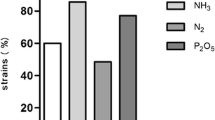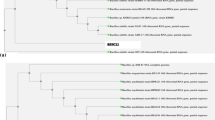Abstract
Bio-inoculants based on native Bacillus spp. have the potential to resuscitate the short fallow Jhum (slash and burn), degraded agro-ecosystem of Northeast India. Plant growth-promoting (PGP) native microbial isolates were investigated for reinvigorating growth of an upland rice variety (Bhalum). Of the 37 distinct bacterial isolates from fields left fallow for 2 years, 27% exhibited two or more PGP traits. Three native isolate strains SH2, MB1 and SS2 were selected as bio-inoculators, based on their levels of indole production, phosphate solubilization, siderophore and HCN production. They also showed no apparent toxicity on the tested rice seeds while enhancing the germination vigor of rice seeds with increased shoot length (39.7%), root length (37%) and plant height (32.7%) when compared to the untreated seeds. Under greenhouse conditions, plants derived from seeds treated with SH2, MB1 and SS2, displayed significant increments and enhanced growth biomass with 39.7% and 37.1% enhancement in shoot and root development versus the control. Phylogenetic analysis based on 16S rRNA sequences characterized SH2, MBI and SS2 as Bacillus luti, B. pacifus, and B. subtilis, respectively. The NCBI GenBank database and the phylogenetic dendrogram generated confirmed their identity with their related type strains. Their robust physiological response to temperature, pH and salt stress will bolster survival in the harsh slash-burn and shifting agriculture cycle. Consequently, application of SH2, MBI and SS2 would maximize growth productivity engendering the eco-restoration, sustainability and resolving low crop productivity of the short fallow Jhum agro-ecosystem







Similar content being viewed by others
References
Swami S (2018) Shifting cultivation: a tribal way of life in north east India and alternative approaches for increasing productivity. Pharm Innov J 7(3):380–385
Ramakrishnan PS (1984) The science behind rotational bush fallow agriculture system (jhum). Proc Indian Acad Sci (Plant Sci) 93:379–400
Ye L, Zhao X, Bao E, Li J, Zou Z, Cao K (2020) Bio-organic fertilizer with reduced rates of chemical fertilization improves soil fertility and enhances tomato yield and quality. Sci Rep 10:177
Sansinenea E (2019) Bacillus spp.: as plant growth-promoting bacteria. In: Singh HB, Keswani C, Reddy MS, Sansinenea E, Garcia-Estrada C (eds) Secondary metabolites of plant growth promoting rhizomicroorgamisms. Springer, Singapore, p 225
Sharma A, Shankhdhar D, Sharma A, Shankhdhar SC (2014) Growth promotion of the rice genotypes by PGPRs isolated from rice rhizosphere. J Soil Sci Plant Nut 14:505–517
Tsavkelova EA, Klimova SY, Cherdyntseva TA, Netrusov AI (2006) Microbial producers of plant growth stimulators and their practical use: a review. Appl Biochem Microbiol 42(2):117–126
Pikovskaya RI (1948) Mobilization of phosphorous in soil in connection with vital activity of some microbial species. Microbiologiya 17:362–370
Lowry OH, Lopez JA (1946) The determination of inorganic phosphate in the presence of labile phosphate esters. J Biol Chem 162:421–428
Brick JM, Bostock RM, Silverstone SE (1991) Rapid in situ assay for indole acetic acid production by bacteria immobilized on nitrocellulose membrane. Appl Environ Microbiol 57:535–538
Cappuccino JC, Sherman N (1992) Microbiology: a laboratory manual, 3rd edn. Benjamin/Cummings, New York, pp 125–179
Schwyn B, Neilands JB (1987) Universal chemical assay for the detection and determination of siderophores. Anal Biochem 160(1):47–56
Bakker AW, Schipper B (1987) Microbial cyanide production in the rhizosphere in relation to potato yield reduction and Pseudomonas spp. mediated plant growth stimulation. Soil Biol Biochem 19:451–457
Chithrashree AC, Udayashankar S, Nayaka C, Reddy MS, Srinivas C (2011) Plant growth-promoting rhizobacteria mediate induced systemic resistance in rice against bacterial leaf blight caused by Xanthomonas oryzae pv. Oryzae. Biol Control 59:114–122
International Rules for Seed Testing (2003) Proceedings of the international seed testing association, international rules for seed testing. Seed Sci Technol 21:25–30
Buchanan RE, Gibbon NE (1974) Bergey’s manual of determinative bacteriology, 8th edn. The Williams and Wilkin’s Co, Baltimore, pp 1246–1249
Weisburg WG, Barns SM, Pelletier DA, Lane DJ (1991) 16S Ribosomal DNA amplification for phylogenetic study. J Bacteriol 173:697–703
Tamura K, Peterson D, Peterson N, Stecher G, Nei M, Kumar S (2011) MEGA5: molecular evolutionary genetics analysis using maximum likelihood, evolutionary distance, and maximum parsimony methods. Mol Biol Evol 28(10):2731–2739
Emami S, Alikhani HA, Pourbabaei AA, Etesami H, Sarmadian F, Motessharezadeh B (2019) Effect of rhizospheric and endophytic bacteria with multiple plant growth promoting traits on wheat growth. Environ Sci Pollut Res 26:19804–19813
Chandra S, Askari K, Kumari M (2018) Optimization of indole acetic acid production by isolated bacteria from Stevia rebaudiana rhizosphere and its effects on plant growth. J Genet Eng Biotechnol 16(2):581–586
Marra LM, Oliveira-Longatti SM, Soares CRFS, Olivares FL, Moreira FMS (2019) The amount of phosphate solubilization depends on the strain, c-source, organic acids and type of phosphate. Geomicrobiol J 36(3):232–242
Munir I, Bano A, Faisal M (2019) Impact of phosphate solubilizing bacteria on wheat (Triticum aestivum) in the presence of pesticides. Braz J Biol 79(1):29–37
Ahmad F, Ahmad I, Khan MS (2008) Screening of free-living rhizospheric bacteria for their multiple plant growth promoting activities. Microbiol Res 163(2):173–181
Rangjaroen C, Lumyong S, Sloan WT, Sungthong R (2019) Herbicide-tolerant endophytic bacteria of rice plants as the biopriming agents for fertility recovery and disease suppression of unhealthy rice seeds. BMC Plant Biol 19:580
Gholami A, Shahsavani S, Nezarat S (2009) The effect of Plant Growth Promoting Rhizobacteria (PGPR) on germination, seedling growth and yield of maize. Int J Biol Life Sci 5:35–40
Vessey JK (2003) Plant growth promoting rhizobacteria as biofertilizers. Plant Soil 255:571–586
Banerjee A, Bareh DA, Joshi SR (2017) Native microorganisms as potent bioinoculants for plant growth promotion in shifting agriculture (Jhum) systems. J Soil Sci Plant Nutr 17(1):127–140
Bal HB, Nayak L, Das S, Adhya TK (2013) Isolation of ACC deaminase producing PGPR from rice rhizosphere and evaluating their plant growth promoting activity under salt stress. Plant Soil 366:93–105
Senthilkumar M, Swarnlakshmi K, Govindasamy V, Lee YK, Annapurna K (2009) Biocontrol potential of soybean bacterial endophytes against charcoal rot fungus Rhizoctonia bataticola. Curr Microbiol 58:288–293
Kumar R, Meena VS (2016) Towards the sustainable management of problematic soils in Northeast India. In: Bisht J, Meena V, Mishra P, Pattanayak A (eds) Conservation agriculture. Springer, Singapore
Nautiyal S, Srivastava S, Chauhan PS, Seem K, Mishra A, Sopory SK (2013) Plant growth-promoting bacteria Bacillus amyloliquefaciens NBRISN13 modulates gene expression profile of leaf and rhizosphere community in rice during salt stress. Plant Physiol Biochem 66:1–9
Acknowledgements
The authors acknowledge the financial support provided by MoEF and CC, Govt of India (MoEFCC-NMHS/LG-2016/005) to carry out the present study. LS and SRJ thank DST-FIST[SR/FST/LSI-666/2016(C)] and UGC-SAP[F.4-7/2016/DRS-1(SAP-II)] for financial support to the parent department.
Author information
Authors and Affiliations
Contributions
SKB, SRJ and LS designed the study. LS carried out the research work. SKB and SRJ wrote the manuscript while LS analyzed the data.
Corresponding author
Ethics declarations
Conflict of interest
The authors declare that they have no conflict of interest.
Ethical Approval and Consent to Participate
The study did not involve engineered or pathogenic organisms and hence no ethical approval was needed. The organisms are of GRAS category. All the authors had their consent to participate in the research study.
Additional information
Publisher's Note
Springer Nature remains neutral with regard to jurisdictional claims in published maps and institutional affiliations.
Significance Statement The study explored native PGP Bacillus spp. as bioinoculants to improve productivity of the upland rice variety as sustainability means for the ever degrading traditional jhum system of agriculture.
Rights and permissions
About this article
Cite this article
Shylla, L., Barik, S.K. & Joshi, S.R. Application of Native Bacillus sp. for Sustainable Jhum Agro-ecosystem. Proc. Natl. Acad. Sci., India, Sect. B Biol. Sci. 91, 799–810 (2021). https://doi.org/10.1007/s40011-021-01263-w
Received:
Revised:
Accepted:
Published:
Issue Date:
DOI: https://doi.org/10.1007/s40011-021-01263-w




